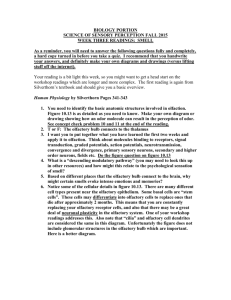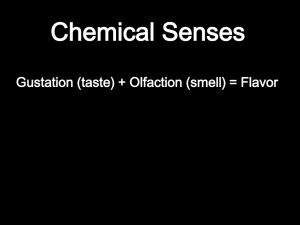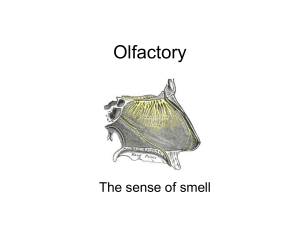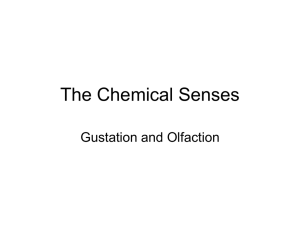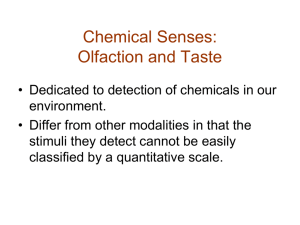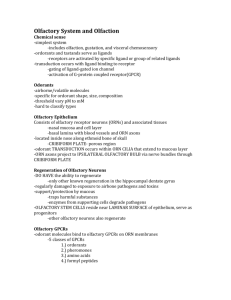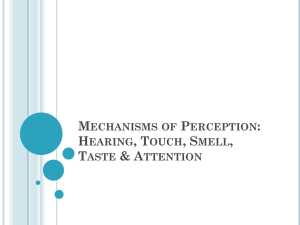Slide 1
advertisement
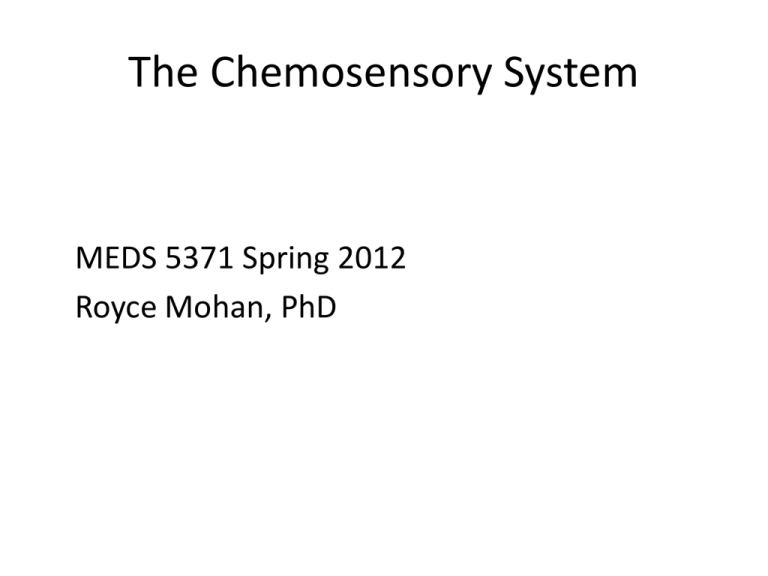
The Chemosensory System MEDS 5371 Spring 2012 Royce Mohan, PhD Our wondrous chemosensory system So how do we choose odorants for perfumes? Penguins use odor-based perception for monogamous relationship for life Ah, so many choices! My mom and dad wear Solo per Te At the nesting sites in March, there is intense competition between the females for a mate followed by a necessarily brief courtship. After a single egg is laid the females return to the sea for many months. This leaves the males to incubate the eggs in the bitter cold until females return only when the chicks begin to hatch. The ChemoSensory System: the Nose The olfactory epithelium Odorant receptor proteins Structure of odorant receptor Molecular mechanisms of odorant transduction Olfactory transduction starts with odorant binding to the GPCR and involves second messengers and ionic currents Very strong adaptation to smells – one of the senses that is strongly or fast adapting Responses of receptor neurons to selected odorants The optimal odorant is very difficult to find. Hence, the science of the perfume industry is still an art. $30 Billion in revenues! Organization of the mammalian olfactory bulb Mitral, tufted cell dendrites in glomerulus; axons to pyriform cortex, amygdala, entorhinal cortex Reinnervate the glomerulus; specific for 1 receptor type Axons grow through cribriform plate Neurons replaced every few weeks Olfactory receptors here; cilia up to 30 m long Organization of the mammalian olfactory bulb 25,000 ORN inputs/ glomerulus 1,000 ORN inputs/ mitral/tufted cell 100 intrinsic neurons (periglomerular, granule) = interneurons / mitral or tufted cell MANY glomeruli / mitral cell; MANY Mitral cells/glomerulus Inputs; much “sharpening” of signal here; mitral cell tufts = dendrites Output to cortex interneurons Transgenic mouse nasal cavity and brain showing olfactory epithelium (OE) and olfactory bulb (OB) from a single olfactory receptor (OR) receptor labeled with lacZ and stained with X-gal Cribriform plate OB OE ORs are widely distributed in the OE Olfactory sensory neurons converge on a single glomerulus Characteristics of OR genes One gene expressed per OSN – pseudogenes [no AUG start; premature STOPs] initially expressed, replaced by functional one Expression of receptor genes around olfactory epithelium is stochastic – not topographic by place in epithelium Humans have about 340 functional olfactory receptor genes, on many chromosomes, in clusters (families) 55 receptor genes respond to octanol Concentration dependent effects Why is my air freshener smelling like celery? oc ta n ol oc ta n ol ODORANT Hexanol Heptanol Octanol Nonanol Hexanoic acid Heptanoic acid Octanoic acid Nonanoic acid ODOR Sweet, herbal, woody Sweet, violet, woody Sweet, rose, orange Fresh, rose, oily floral Rancid, sour, goat-like Rancid, sour, sweaty Rancid, sour, repulsive waxy, cheese, nut-like The olfactory bulb has a stereotyped map of OR inputs Odor coding in the olfactory epithelium (OE) and olfactory bulb (OB) OE: Inputs from different ORs are indicated by different colors; dispersed ensemble of neurons A). A single OR gene probe hybridized to sensory axons in 1 or 2 glomeruli on either side of the olfactory bulb OB: Specific combination of glomeruli whose spatial arrangement is similar among individuals. Partially B). Different OR probes hybridized to different glomeruli and overlapping combinations of OR inputs generate those glomeruli had similar locations in six different bulbs. distinct odor perceptions Schematic diagrams showing the organization of odorant receptor inputs in the olfactory epithelium (OE), olfactory bulb (OB), and olfactory cortex (OC) Inputs from different ORs are segregated in different neurons and glomeruli in the OE and OB. In contrast, it appears that different receptor inputs overlap extensively in the OC (A) and that single cortical neurons receive signals from a combination of receptors (B) The lock and key theory of odorant-receptor interaction does not address how diverse chemical structures have the same odor perception Is the electronic swipe card model a better explanation than the lock and key? The olfactory cortex has a stereotyped map of OR inputs Organization of inputs from the M5 (yellow) and M50 (pink) odorant receptors in the olfactory epithelium, bulb, and cortex. Black lines and abbreviations indicate different areas of the olfactory cortex. AON: anterior olfactory nucleus; PC: piriform cortex; OT: olfactory tubercle; Amg: olfactory nuclei of amygdala; EC: lateral entorhinal cortex. The human taste system Cortical processing unclear All converge to NTS, then thalamus Nerves VII, IX, X from different regions of the mouth The human taste system Human Olfactory System Taste buds and taste papillae Taste buds and taste papillae 50-100 receptor cells in bud; renew every 10 days or so 5-20 axons leave the bud; integration must be happening !! Salty, acidic, sweet, amino acid, bitter ALL represented by cells in the bud Bitter cells do not directly contact nerve – indirect through sweet and amino acid cells Salty, acidic, sweet, amino acid, bitter ALL represented by cells in the bud Peripheral innervation of the tongue Sensory transduction in taste cells Molecular mechanisms of taste transduction via ion channels and G-protein-coupled receptors Main points to remember • Largest family of genes; ORs are GPCRs • 1 OR expressed/neuron; can detect many odorants • Even though many OR genes initially selected for expression, only one will dominate and remain expressed • Odorant sensory neurons converge on a few glomeruli in the OB • Partially overlapping combinations of OR inputs generate distinct odor perceptions in the olfactory cortex • Taste system; salt and acids use ionic channels • Other taste receptors use GPCRs • The neural coding for taste system uses a labeled line code
